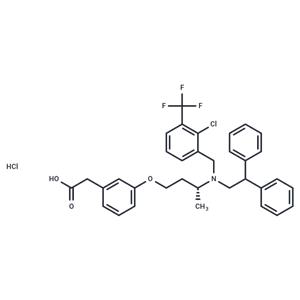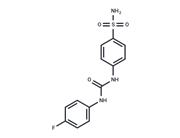| Name | RGX-104 hydrochloride |
| Description | RGX-104 hydrochloride (SB742881) is a liver X receptor (LXR) agonist with potential immunomodulating and antineoplastic activities. It modulates innate immunity via transcriptional activation of the ApoE gene. |
| Cell Research | Myeloid-derived suppressor cells were isolated as previously described from splenic tissue of tumor-bearing mice. One hundred thousand cells were plated in quadruplicates in poly-L-lysine coated plates. After 3 hours of treatment with 1uM RGX-104 or DMSO as vehicle, cells were fixed with 4% PFA for 15 minutes and wash 3 times with 1X PBS prior staining. Rabbit monoclonal anti-Ki67 antibody (1:400 dilution) was applied at 4C overnight. Cells were incubated with Alexa Fluor 488 secondary antibody (1:200 dilution) for one hour at room temperature, counterstained with DAPI (1:1000 dilution) and mounted with Prolong Gold. For the analysis of the percentage of Ki67 positive cells, five fields from each replicate were imaged at 20x magnification using Zeiss Axio Imager fluorescence microscope. |
| Animal Research | For MDSC adoptive transfer experiments into tumor-bearing mice, 2 × 10^6 MDSCs were isolated as described above from C57BL/6 tumor-bearing mice and subsequently labeled with BD Horizon Violet (BV) Proliferation Dye and then adoptively transferred via retro-orbital injection into wild-type mice. Mice were then treated with RGX-104 (100 mg/kg/day) or control diet for 36 hours. Spleens of recipient mice were then harvested and processed for flow cytometry analysis as described above. For MDSC adoptive transfer experiments in to WT and ApoE?/? non-tumor bearing mice, 5 × 10^6 MDSCs were isolated as described above from tumor-bearing mice (either wild-type C57BL/6 or Apoe?/? mice) and subsequently labeled with BV cell tracker dye and then adoptively transferred via retro-orbital injection into either wild-type or Apoe?/? mice. Mice were then treated with GW3965 (100 mg/kg/day) or control diet for 48 hours. Spleens of recipient mice were then harvested and processed for flow cytometry analysis. |
| In vivo | Oral administration of RGX-104 to animals bearing palpable tumors significantly suppressed the growth of multiple cancer types. Strong tumor growth suppression was also observed in animals bearing large tumors. As compared to controls after 8 days of treatment, apoptotic circulating G-MDSCs of total CD45+ lymphocytes in RGX-104-treated (100 mg/kg) mice had a significant increase. |
| Storage | keep away from direct sunlight,keep away from moisture,store at low temperature | Powder: -20°C for 3 years | In solvent: -80°C for 1 year | Shipping with blue ice. |
| Solubility Information | DMSO : 115 mg/mL (181.81 mM)
|
| Keywords | SB-742881 | SB 742881 | RGX-104 Hydrochloride | RGX104 hydrochloride | RGX104 Hydrochloride | RGX-104 | RGX104 | RGX 104 hydrochloride | RGX 104 Hydrochloride | RGX 104 | LXR | Liver X receptor | Inhibitor | inhibit |
| Inhibitors Related | SR9243 | GW6340 | T0901317 | GSK3987 | RGX-104 | SR9238 | GSK2033 | BE1218 | (20S)-Protopanaxatriol | GW3965 hydrochloride | LXR-623 | Rovazolac |
| Related Compound Libraries | Anti-Cancer Clinical Compound Library | NO PAINS Compound Library | Orally Active Compound Library | Clinical Compound Library | Anti-Metabolism Disease Compound Library | Anti-Cancer Drug Library | Anti-Cancer Active Compound Library |

 United States
United States



